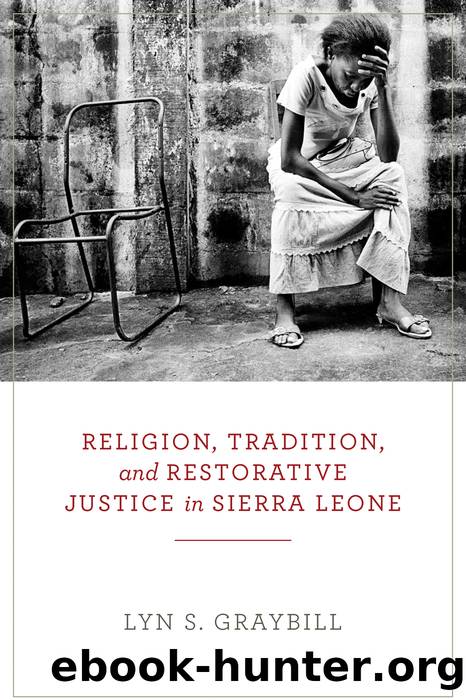Religion, Tradition, and Restorative Justice in Sierra Leone by Graybill Lyn S.;

Author:Graybill, Lyn S.;
Language: eng
Format: epub
Publisher: University of Notre Dame Press
Published: 2017-08-14T16:00:00+00:00
RECONCILIATION AND DEVELOPMENT
The program recognizes that the ceremonies are only the beginning of the process. A novel component is that after the harm is addressed through confession and ritual, a group activity is undertaken to cement the relationships. In addition to group activities, such as friendly football matches, dances, and feasts, economic ventures, such as community farms, have been attempted. This is important since, as John Paul Lederach notes, the more ties people have with each other and the more they acknowledge their interdependence, the more likely they are to reconcile.144
In Kailahun, people have begun farming together againâsomething that had not been practiced since before the war. To encourage the people to work together as a symbol of unity, Fambul Tok donated rice seedlings and cassava trunks throughout Kailahun. Several villages that cultivated rice agreed to set aside some of the harvest for food for future reconciliation ceremonies. The remaining seeds were given to needy community members on loan, payable after the next harvest. Other communities that planted cassava together decided to process it into a popular dish, garri, to sell at market, using the proceeds to open a community account. Several communities in Kailahun with community farms have reported record harvests, which they attribute to the cleansing of the land that resulted from the reconciliation ceremonies. For the first time since the war, they do not have to import rice.145 Following the examples of community farms in Kailahun district, Moyamba district after the Fambul Tok ceremonies also embarked on group farms, turning acres of swampland into productive rice farms. At the end of Fambul Tokâs second year, thirty community farms, or âpeace farms,â had been established in the districts where Fambul Tok ceremonies had been held.146
In Kailahunâs Golan village, the community worked together to construct a maternity home encouraged, said the town chief, by the Fambul Tok reconciliation ceremonies, which had inspired them to work together. In Madina village, using funds from their community farm, residents are buying cement to build a barray.147 They also worked together to build a guesthouse to show strangers they are united in hospitality.148 In Kenewa village, the people, aided by a donation of zinc from Fambul Tok, built a roof for the court barray where they come together to settle future disputes.149 One village participant, whose father, the town chief, had been brutally tortured and killed by the rebels, made this link between reconciliation and development: âI decided we should forgive [because] the act has been done, and if we say we are going to [take] revenge, then there will be no peace in our community, there will be no development.â150
Incidents of individual perpetrators assisting victims have been documented as well. For instance, the man from Daabu who had killed the seven-year-old daughter of his neighbor now looks for ways to assist the woman and her family. In Konoâs Foindor village, using zinc and nails donated by Fambul Tok, a perpetrator is assisting in rebuilding his victimâs house. These examples show how Fambul
Download
This site does not store any files on its server. We only index and link to content provided by other sites. Please contact the content providers to delete copyright contents if any and email us, we'll remove relevant links or contents immediately.
The Lost Art of Listening by Michael P. Nichols(6472)
Why I Am Not A Calvinist by Dr. Peter S. Ruckman(3769)
The Rosicrucians by Christopher McIntosh(3049)
Wicca: a guide for the solitary practitioner by Scott Cunningham(2704)
Signature in the Cell: DNA and the Evidence for Intelligent Design by Stephen C. Meyer(2501)
Real Sex by Lauren F. Winner(2474)
The Holy Spirit by Billy Graham(2416)
To Light a Sacred Flame by Silver RavenWolf(2353)
The End of Faith by Sam Harris(2288)
The Gnostic Gospels by Pagels Elaine(2026)
Nine Parts of Desire by Geraldine Brooks(2006)
Waking Up by Sam Harris(1958)
Heavens on Earth by Michael Shermer(1955)
Devil, The by Almond Philip C(1899)
Jesus by Paul Johnson(1887)
The God delusion by Richard Dawkins(1848)
Kundalini by Gopi Krishna(1824)
Chosen by God by R. C. Sproul(1760)
The Nature of Consciousness by Rupert Spira(1689)
